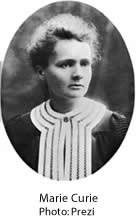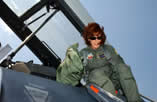Women Who Make a Difference in Optics – Every Day
Tracy Schario, APR
I’d love to fly like these women – figuratively and literally. As we reflect on the past 100 years of scientific progress throughout The Optical Society’s Centennial year, we celebrate the fact that women have not only been core to our society, but they have also been pioneers in science – particularly optics. We interviewed three OSA Presidents—Elsa Garmire (1993), Janet Fender (1996), and Donna Strickland (2013)—and OSA Fellow Mary Lou Jepsen, one of the world’s foremost display innovators and entrepreneurs, who was recently the keynote speaker at our Light the Future speaker series at OFC.
From these women, we’ve learned that despite often being the only woman in the room for many years, in the face of numerous misconceptions or doubts, the possibilities for women in optics are endless and the contributions to be made are great.
“If you want a career in science, you have to just do it and put your blinders on,” says 2013 OSA President Donna Strickland. “I knew what I was good at; no one could tell me to pursue something I wasn’t good at.”
The Only Woman in the Room
If you ask 1993 OSA President Elsa Garmire about how she first became acquainted with The Optical Society, she’ll tell you about a physics conference she attended in Puerto Rico in 1966. The conference opened with a host on stage welcoming attendees with the introduction, “Welcome Gentlemen…and Mrs. Garmire.” Elsa – who was eight months pregnant at the time – was immediately reminded that she was one of the few women in her field. Elsa went on to pioneer laser technology with Charles Townes and is a member of the National Academies of Engineers and Inventors, among many other accolades. Yet, early in her career, she didn’t use her first name on research papers to prevent reviewer bias. I don’t have to imagine what that was like thanks to trailblazers like Elsa.
 Today, women are much more visible in science leadership than they were in 1966, but many women in male-dominated STEM careers share similar experiences to Elsa’s. UNESCO finds that women represent only 28 percent of researchers worldwide. Despite making up nearly half of the U.S. college-educated workforce, women were awarded just 18 percent of bachelor’s degrees in computer sciences, 19 percent in engineering and 19 percent in physics in 2015. Meanwhile, in practice, the U.S. Commerce Dept. reports that women hold less than 25 percent of STEM jobs.
Today, women are much more visible in science leadership than they were in 1966, but many women in male-dominated STEM careers share similar experiences to Elsa’s. UNESCO finds that women represent only 28 percent of researchers worldwide. Despite making up nearly half of the U.S. college-educated workforce, women were awarded just 18 percent of bachelor’s degrees in computer sciences, 19 percent in engineering and 19 percent in physics in 2015. Meanwhile, in practice, the U.S. Commerce Dept. reports that women hold less than 25 percent of STEM jobs.Mary Lou Jepsen points out that the numbers are even smaller on top, with 18 out of the 583 Nobel prizes to-date in the sciences having been awarded to women. Jepsen explains that this measure is out of proportion to the contributions women have actually made to science to-date: “The numbers are small at the top for reasons of opportunity and bias. For example, Marie Curie almost didn’t get her Nobel in physics – the Nobel Committee wanted to give the prize only to her husband. Pierre [Curie] said that if the Nobel Committee had to pick just one of the Curies for the prize, to pick Marie, because it was her idea and she did most of the work.” And keep your eye on Mary Lou. She’s left Facebook to “cure cancer with rainbows” via her new startup Open Water, with a goal to produce affordable MRI diagnostics for early detection of cancer and heart disease, among other maladies.
Challenging the Status Quo
2013 OSA President Donna Strickland once had a high school guidance counselor tell her that “math and science were boy subjects.” Asked about how she reacted to this, Strickland says, “I didn’t feel deflated; I just thought that was a very stupid thing to say.” Anecdotes like these are not uncommon, and stereotypes about women in science have long existed and persist. Donna is a champion for women in optics and is known for building the photonics industry in Canada. We learn the value of persistence and commitment in overcoming obstacles.
 Mary Lou describes what we see today, “It’s no longer explicit biases, but implicit biases. There is strong evidence showing the contributions of women are not fairly noted.” Even though we might not live in the 19th century, Mary Lou states, “None of us alive today made this cultural bias, but it falls on us to debug it. [Otherwise,] we are losing out on the full contribution of half of the population.” 1996 OSA President Janet Fender suggests, “No matter how much training you get in diversity in the workplace, it’s just going to take exposure and women inserting themselves into ‘non-traditional roles’ – if you will – to [see more change].”
Mary Lou describes what we see today, “It’s no longer explicit biases, but implicit biases. There is strong evidence showing the contributions of women are not fairly noted.” Even though we might not live in the 19th century, Mary Lou states, “None of us alive today made this cultural bias, but it falls on us to debug it. [Otherwise,] we are losing out on the full contribution of half of the population.” 1996 OSA President Janet Fender suggests, “No matter how much training you get in diversity in the workplace, it’s just going to take exposure and women inserting themselves into ‘non-traditional roles’ – if you will – to [see more change].”Study Physics, Become A CEO?
So why don’t we see more women working in STEM fields? Janet contends that there are misconceptions about what a career in STEM can look like. Fender, who works as Command Chief Scientist for the U.S. Air Force, admits that when she started out, she thought her interest in optics
 could only lead her to a career in academics or at a research laboratory. To her, business executives had MBAs from Harvard and scientists wore white lab coats. What she found throughout her career, however, was very different.
could only lead her to a career in academics or at a research laboratory. To her, business executives had MBAs from Harvard and scientists wore white lab coats. What she found throughout her career, however, was very different.“We need more of an emphasis on the breadth of possibilities for women in STEM – you can be an executive and have a background in science and engineering,” Fender says. “Think about how important it is for educated, experienced scientists to be making a company’s investment decisions – whether in industry or government – rather than managers, without the technical skills or experience.” Fender wants girls interested in science today to know, “You can lead a billion dollar program if you’re so inclined; you can develop the next generation of fighter aircraft if you’re so inclined.”
Be Inspired
“If you look deeply into any field you will find there women always there, but their contributions have largely been written out of history,” Mary Lou says. Women have always worked in science, whether history documented it or not. The opportunity remains for future generations of women to look to the trailblazers – like Maria Goeppert-Mayer, Hilda Kingslake, Mary Warga, or any of The Optical Society’s women leaders – for inspiration for the future. With a woman CEO – Liz Rogan – at the helm of OSA for more than a decade, Janet says, “The Optical Society makes sure every opportunity – from events to activities and research – is open to the next generations of women leaders.”
While women in science have made tremendous progress, more remains to be done. It begins at home and in the classroom. Take a moment to watch this compelling #MakeWhatsNext video and make every day #InternationalWomensDay.
